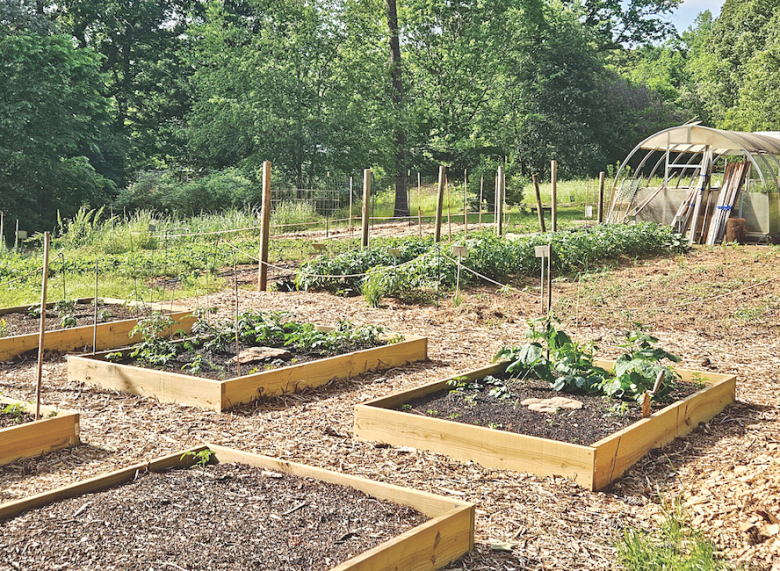
In April, residents of Southeast Atlanta gathered to celebrate the rebirth of a historic green space: Red’s Farm at Ormewood Park. Once an off-the-radar community farm stewarded by a local grower, the site has been officially designated a city park, a move local advocates hope will become a model to combat rising food insecurity and persistent food deserts.
The city’s official recognition of Red’s Farm represents more than a name change—it’s a shift in how green spaces are valued and preserved, according to John O. Baiyewu, urban agriculture and food systems director for the City of Atlanta’s Office of Sustainability and Resilience.
“Red’s Farm has long been a place where the community came together,” said Baiyewu. “Now that it’s a city park, it’s about finding ways to maintain the original culture while also expanding the vision.”
The transition of Red’s Farm into a city park marks a new chapter for the beloved community space, blending its deep-rooted legacy with fresh possibilities. Longtime residents recall neighborhood cookouts, youth programs and impromptu music nights that gave the space its heart. As city officials and local leaders collaborate on the park’s future, efforts are focused on preserving its identity while introducing new amenities that serve a wider audience — from community gardens to cultural events.
As it transitions into a city park, efforts are being made to honor Red’s Farm’s past while introducing new programs and features that serve a broader population. The goal is to strike a balance between cultural preservation and inclusive growth. That shift became official after a series of land transfers that ultimately placed the property in public hands.
According to Rachel Ezzo, board chair of Urban Farm in Ormewood, Inc., the land, previously owned by a local family, was sold to the Conservation Fund and then transferred to the city, solidifying its role as a public resource. While the Atlanta Parks Department oversees basic operations, the site is still largely maintained by the same community members who nurtured it from the beginning. And while the farm’s transformation is significant, advocates say it’s part of a broader effort by the city to invest in local food systems.
Baiyewu’s office has supported other agricultural initiatives through mini-grants totaling over $300,000 funded by the American Rescue Plan Act. These initiatives support food-growing organizations, resident gardens, and small farms. The mini-grants reflect a broader effort by Baiyewu’s office to address food insecurity and economic recovery at the neighborhood level. By directing federal funds toward grassroots agricultural initiatives, the office is helping build long-term capacity for local food production while supporting community-led solutions.
“It’s not just about creating farms for business,” Baiyewu said. “We want to support people growing food in their backyards.” Baiyewu’s remarks highlight a shift toward more inclusive urban agriculture, emphasizing that food production isn’t limited to commercial ventures. By encouraging backyard gardening and small-scale growing, the initiative aims to foster self-sufficiency, strengthen community ties, and make fresh food more accessible to residents across the city.
Those investments have helped position Atlanta as a national leader in food access innovation. With more than 70 neighborhoods classified as food deserts, the city recently launched programs to expand grocery retail access through investments from Invest Atlanta and the Office of Policy, as reported by Supermarket News.
One of the city’s most ambitious efforts includes supporting local food entrepreneurs and mobile markets that bring fresh produce directly into underserved communities.
These initiatives not only aim to close the geographic gap in food access but also empower residents to play an active role in reshaping their local food systems. By partnering with grassroots organizations and leveraging public-private funding, Atlanta is working to ensure that healthy, affordable food is within reach for all its residents.
New stores, such as Savvy Market on Campbellton Road, are among the solutions, but many advocates argue that deeper change must come from the ground up. Still, structural challenges remain, particularly in neighborhoods historically excluded from access to fresh food.
That’s where places like Five Points Urban Farm come in. Elias Capello, an anthropology professor at Savannah Art and Design College, leads student volunteer efforts at the garden’s Garnett MARTA station location. At the grassroots level, community farms are working to fill that gap with education and hands-on engagement.
“Many of my students don’t initially realize they’re food insecure,” Capello said. “We talk about how systems of racism influence where food is accessible, and students begin to understand that growing their own food is both a life skill and a form of empowerment.”
Capello’s approach is part of a growing movement in Atlanta schools to integrate food justice into the curriculum, connecting students to the broader social and historical context of food access. Through hands-on gardening projects and classroom discussions, educators are equipping young people with the tools to critically examine inequities in their communities and advocate for change. These programs not only teach practical skills but also foster a deeper understanding of how food intersects with identity, health, and systemic inequality.
Capello’s insight speaks to a deeper truth: food insecurity isn’t always obvious, especially for young people. By connecting systemic racism to food access, her students start to see the bigger picture—how growing their own food isn’t just practical, it’s a powerful act of reclaiming agency and creating change within their communities.
Capello emphasized that even gardens with limited access, such as those near public housing projects or pollinator plots downtown, can become powerful tools for education and healing when properly maintained and labeled.
For Ormewood residents like Jessica Turner, the transformation has been personal. “Before this, my thumb wasn’t green,” she said. “Now I’m learning how to grow my own food, and it’s one of the best things I’ve done for myself.”



